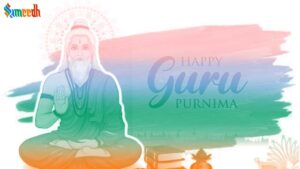Guru creates a path for us to achieve the ultimate truth – Brahma (ब्रह्म). Gu means darkness. Ru means the remover. Guru Purnima is celebrated on full moon day (पूर्णिमा) of the Ashadha month. It is the birthday of Ved Vyasa. Ved Vyasa was the author of Mahabharat and Puran.

Guru Purnima is after 4 days of Devshayani Ekadashi when Lord Vishnu falls into a deep slumber of ‘dhyaan’. During these 4 days Gurudev takes over the operation of the Universe to help Lord Vishnu get some rest. Right after Guru Purnima, The month of Sawan starts, Lord Shiv takes over the operation for one month of the Universe to help Lord Vishnu get some rest and rejuvination.
Brahma, Vishnu and Shiv – trinity of Gods that is responsible for creation, sustenance and destruction – are the highest forms of worship in Hinduism. Guru is considered higher. Guru creates a path for us to achieve the ultimate truth – Brahma (ब्रह्म). That is why I bow down to the Guru. Gu means darkness. Ru means the remover. Guru = remover of darkness. That is why Guru is revered.
Vedas are eternal. They are revered as the top form of knowledge. They were taught and passed down by श्रुति (by voice). Before they were written, they were heard. And it was Guru that taught the Vedas to his/her disciples. Students seeked knowledge … knowledge of self, knowledge of self-realization, knowledge of ultimate reality. Every knowledge begins with Guru. Every truth is explained by Guru. Every reality is demystified by Guru. Guru leads us to enlightenment. That is why Guru is respected.
Significance
- Honoring Gurus: In Hinduism, the guru is revered as a spiritual guide and mentor who leads disciples on the path to enlightenment and knowledge. Guru Purnima is a day to express gratitude and reverence towards one’s guru.
- Vyasa Purnima: The day is also celebrated as Vyasa Purnima to honor Ved Vyasa, who played a pivotal role in preserving and disseminating Hindu scriptures.
- Spiritual Practices: Devotees engage in various spiritual practices, including meditation, prayer, and chanting, to seek the blessings of their gurus.
Rituals and Traditions
- Guru Puja: Devotees perform a special puja (ritual) to honor their gurus. This may include offering flowers, fruits, and other symbolic gifts.
- Scripture Reading: Sacred texts composed by Ved Vyasa, such as the Mahabharat, Purans, and Vedas, are read and recited.
- Spiritual Discourses: Satsangs (spiritual gatherings) and discourses are organized to discuss the teachings of great gurus.
- Acts of Service: Followers engage in acts of charity and service as a way to honor their gurus’ teachings.
Guru Purnima is celebrated on full moon day (पूर्णिमा) of the Ashadha month. It is birthday of Ved Vyasa. Ved Vyasa was the author of Mahabharat and Purans. He is considered the best author of all times. His ability to convey powerful ideas, philosophies and profound meanings in poetic story-format was uncanny. These scriptures are unimaginable. They are source of all truths. There is nothing comparable.
Mother is the first Guru for a child. She teaches us our first lessons. She continues to teach with compassion and utmost love. Father is our next Guru. He teaches us lessons of life. Teachers at school or acharyas at ashramas impart on us the knowledge – knowledge of different kalas, knowledge to earn, knowledge to learn, knowledge to know. The best teacher is the one that teaches us how to learn.
A common mantra recited on Guru Purnima to honor and seek blessings from the guru is the “Guru Stotram,” part of which includes the famous “Guru Vandana” shloka.
Guru Purnima is a profound celebration in Hinduism, emphasizing the guru-disciple relationship’s sacredness and importance. By honoring their gurus, devotees express gratitude for the wisdom and guidance received, which leads them on the path to spiritual and personal growth. Reciting the Guru mantra and engaging in various rituals are ways to seek blessings and reinforce the teachings imparted by their revered gurus.